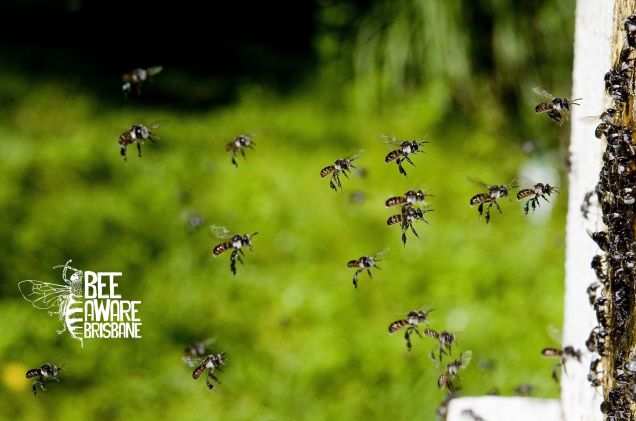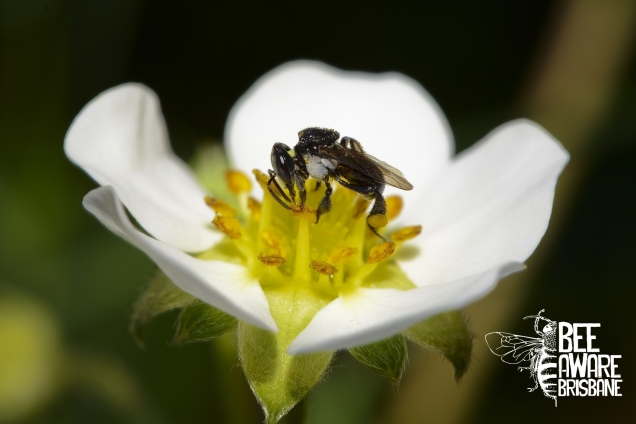Have you ever felt underappreciated? As if people assume you can only contribute one skill to the world, and not much else…?
Imagine how bees feel. Not only do 99.9% of bee species live in the shadow of the European honey bee, most of the time they only get credit for pollinating flowers. And a few make honey. That’s all they do, right?
Actually, no. Bees do a lot of other things in their ecosystems. They have a very active life outside their relationship with flowers.
The stingless bees (Tribe: Meliponini) are some of the most intriguing. There are about 500 species of stingless bee around the world, mostly in tropical and subtropical regions. Like honey bees, they also make honey; albeit in gourmet, rather than commercial, quantities. (Their honey also has a very different flavour to the honey you buy in the supermarket.)

Some meliponine species can be semi-domesticated and ‘managed’ as pollinators and honey producers, just like honey bees. Stingless beekeeping (called meliponiculture) is common in many traditional cultures, particularly throughout central America and south-east Asia. It is an important element of sustainable rural livelihoods in many countries. In fact, it could even be older than apiculture, the practice of keeping European honey bees.
In Australia, the Yolngu people of Arnhem Land placed high value on the complex ecology of the sugarbag ecosystem, preferring to track and gather wild hives (sometimes using what ecologists now call mark-recapture methods), rather than domesticate them. ‘Sugarbag’ referred to everything – the bees, their hive, the honey, the Yolngu harvesters, the trees – not just the honey.
Knowing that sugarbag is part of an interconnected system, linked to the hunters of the honey, bees, nests, eucalyptus trees, flowers, a particular bee-fly, and a specific season, we can see that it would be counter to Yolngu philosophy to separate the bees from the sugarbag complex as a whole in order to produce a greater amount of honey in the form of containing bees in hives.
~ Katherine Fijn, Sugarbag Dreaming: the significance of bees to Yolngu in Arnhem Land, Australia (2014)
Thankfully, meliponiculture is seeing a revival in Australia, mostly along the east coast. Stingless bee colonies are used as ‘managed pollinators’ (in place of honey bee hives) in lots of our favourite crops, like macadamia, blueberry and strawberry. My friend Toby Smith, who manages Bee Aware Brisbane, keeps (and sometimes rescues) stingless bee colonies in metropolitan Brisbane. Take that, Apis mellifera!


But there is a lot more to bees than pollinating flowers and making honey. Many bee species also collect plant resins, to use either as sealants or defence parapets for their hives, or to create their own individual anti-predator ‘perfume’. The chemicals in the resins create scents that repel predators from hives and individual bees.
Stingless bees use resins to build their honey pots and repel predators, like ants, from their nests. This great research published last year showed that mixed resins from multiple tree species was more effective at repelling predators than a single-species resin. So what happens to stingless bee hives in landscapes dominated by monoculture resin sources, like pine plantations?
Resins are not the only non-floral resource that bees need. Some Central American species are necrophagous, which means they feed on soft tissue – usually carrion, but sometimes other insect larvae. Some are so efficient (species in the Trigona hypogea group) that they have lost their ability to transport pollen…because they no longer need to eat it.
Yes, that means they’re not actually pollinators.
But they are still providing an ecosystem service by removing carrion, an activity which enhances nutrient recycling and reduces disease spread.
Some species, like Trigona spinipes (the Brazilian irapuá bee), are actually a ‘pest’ in some agroecosystems – T. spinipes has been documented damaging broccoli and cucumber crops. Others also predate on wasp larvae of the Polistinae paper wasps, which are important predators of other insect pests.
Does your head hurt yet?
Even more intriguingly, Australian stingless bees can add ‘seed dispersal’ to their repertoire. Seed dispersal by animals is key to reproduction in many plant species. We know that animals and birds complete this process by feeding on fruits and dispersing the seeds across the landscape, either through physical movement or faeces. But, bees? Did you ever think of bees as a seed disperser?
It all comes back to resins, not flowers. So far, this interaction is known from the eucalypt tree Corymbia torelliana, also known as the cadaghi, a native of northern Queensland. (It is now an environmental weed in south-east Queensland and northern New South Wales.) When stingless bees visit cadaghi, they turn up for the resin party and leave with a seed slyly slipped in their handbag. This is called ‘melittochory’ – bee-mediated seed dispersal. And the cadaghi is not innocent of this exchange – they may actually lure the bees in!
Dr Sara Leonhardt researched these interactions as part of her PhD research and found that the resin chemistry of the cadaghi may be “particularly well adapted” to attract the resin-collecting bees. As the bees collect resin from cadaghi gumnuts, they often inadvertently carry off a seed in the mix, depositing in or near their nest once they return home.
And thus spread the cadaghi.
So, yes, bees are great pollinators. But let’s not succumb to reductionist labels. Bees also do a lot more than they get credit for.

© Manu Saunders 2015
Fascinating read, Manu! I had no idea about the seed dispersal, carrion removal or wasp larve predation abilities of some bee species. Thank you!
LikeLiked by 1 person
Thanks Jane! Yes, they’re pretty amazing little creatures 🙂
LikeLiked by 1 person
Yes, fascinating. I’m not sure what I think of carrion eating bees. ( A little bit “wow” and a little bit “ergh”, maybe). You’re definitely doing your bit to give these little guys a voice
LikeLiked by 1 person
“A little bit “wow” and a little bit “ergh”..”
That sums it up perfectly! 🙂
LikeLike
Bee-utiful post Manu, thanks for highlighting even more resins to love bees. 😊
LikeLiked by 1 person
Thanks Paula! 😉
LikeLiked by 1 person